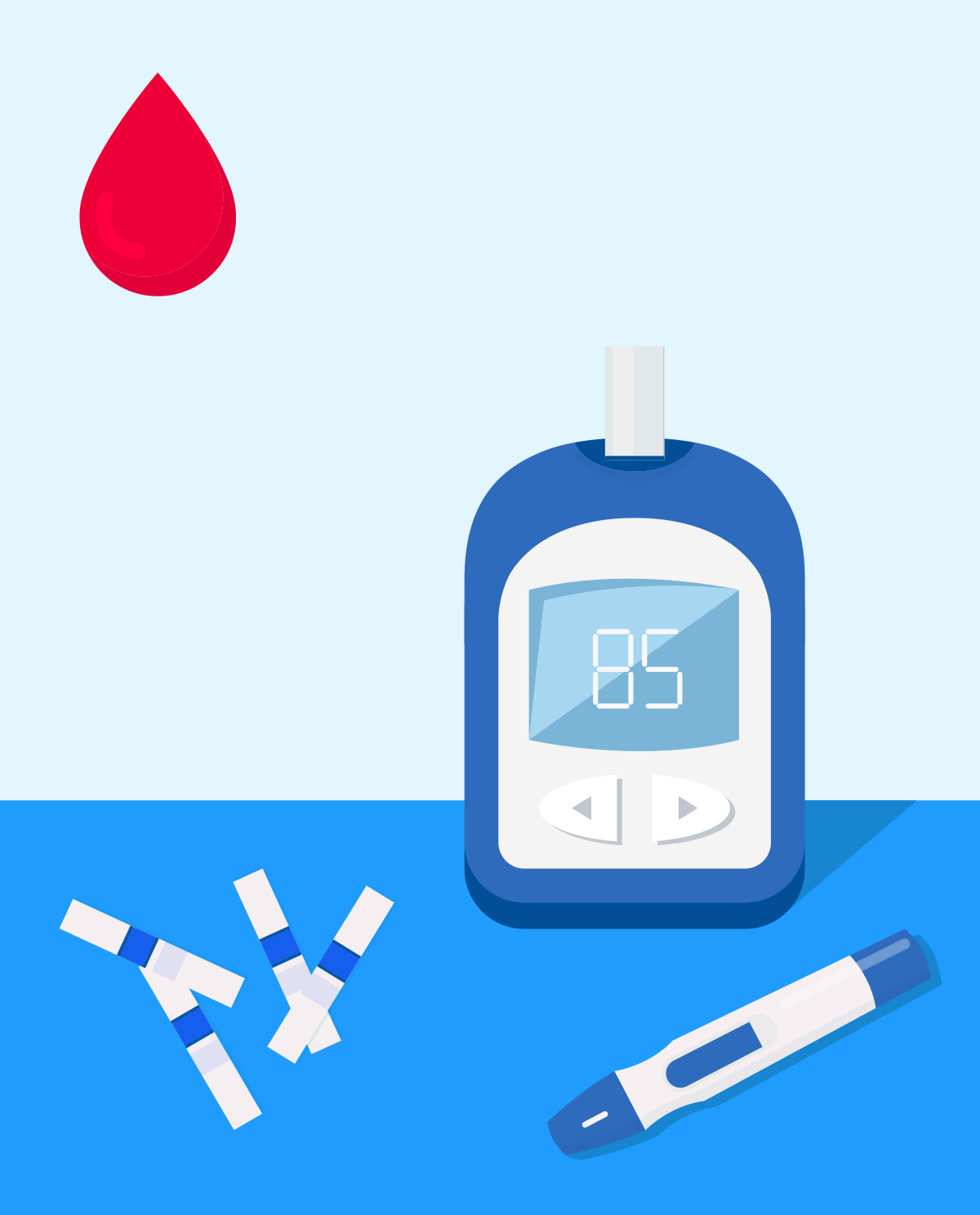What is a glucometer and how does it work?
The meter is a portable, medical diagnostic device used for measuring and reading capillary glucose levels. The device is intended for home use should be easy to use. Start the meter, insert the test strip, and then apply a drop of blood to the appropriate place on the strip. Blood for measurement should be obtained from the fingertip or earlobe by puncturing with a sterile needle. Depending on the design of the device, the glucose is measured using:
- photochemical method - the amount of reflected light dependent on the color change of the test field is recorded,
- electrochemical method - the intensity of electric current flowing through the reactive field on the test strip is measured.
After just a few seconds, the meter automatically reads and analyzes changes and then displays the result in numerical form.
Based on daily blood glucose measurements, diabetics can make decisions on insulin doses and meals. Using the meter allows for precise insulin dosing depending on the current level of sugar in the blood. Glucometers are also useful for patients who are treated only with oral medications. Regular self-monitoring allows you to quickly detect both too low and too high blood sugar levels.
Which glucometer should I choose?
There are many types of glucometers on the market. When buying a sugar measuring apparatus it is worth paying attention to several important parameters. For many patients, the first is the purchase price of the device. The prices of glucometers range from $40 to $60. The cheapest ones are the most basic, and the more expensive ones are equipped with additional functions, improving the use of the meter.
The main factor which should be taken into account is the accuracy of the measurement. We define it as a match between the measurement result and the actual blood glucose value. Before purchasing the meter, it is necessary to carefully read the materials provided by the manufacturer, which must contain data on the accuracy of measurements. A commonly used document specifying the required accuracy of measurements using glucose meters used in glucose self-monitoring is ISO 15197: 2015 . The most acceptable measurement error for glycemia:
- <100 mg / dl (5.55 mmol / l) is ± 15 mg / dl (0.83 mmol / l),
- ≥ 100 mg / dl (5.55 mmol / l) is ± 15% of the reference value.
The accuracy and reliability of blood glucose readings is crucial for diabetics because this information has an impact on decisions regarding disease control.
How do I use the meter correctly?
-
Be sure to read the instructions that come with the meter.
In order for the meter to function properly and reliably, its operating principle and the markings which appear on the display should be understood. Before using the meter, read the instruction manual carefully. It is also very important to always use the same meter. The simultaneous use of several glucometers may introduce confusion and unnecessary changes in treatment.
-
How can I prepare for the test?
- Before each measurement, wash your hands with warm soapy water and then dry them thoroughly. Remnants of hand cream, food, sweet drinks, dirt or sweat can change the results, usually making them much higher.
- It is also important that the equipment for measurement is kept clean, so it is unacceptable to store used strips and lancing devices together with the meter.
- There is no need to disinfect the finger pad with alcohol or another disinfectant. However, if it is used, the puncture of the pad should be performed only after its full evaporation. Even a small amount of disinfectant can cause false results.
-
How can I take a blood sample?
- For puncturing your fingertip, it is worth using the lancets attached to the glucose meters, this should be less painful. Each lancing device contains a matching type of needle that can be obtained without a prescription at a pharmacy.
- The lancing device is intended for one person only and must not be used by other people because there is a risk of bloodstream infections being transmitted! The needle in the device should be changed after each use.
- To obtain a drop of blood, puncture the side of the fingers III, IV or V of the palm of both hands. Usually, blood is not collected from the forefinger and thumb, and if necessary, blood should be collected from the non-dominant hand.
- The depth of the puncture should be chosen so that the blood spontaneously flows out. The current glucose meters only need a small drop of blood. If the drop obtained is too small, it should not be squeezed from the fingertips because tissue fluid is also squeezed and this may distort the measurement.
- If the drop is too small, check that the puncture depth set in the lancet is not too low. Then it's worth warming up your hands. You can also try lowering your hand, and massaging your hand from your arm to your hand.
- If it is not possible to take blood for examination from the fingertips, you can prick the earlobe.
Some glucometers have a special plastic overlay, which allows you to take blood for testing from alternative places, such as: thumbs, forearm, thigh, abdominal area.
- Each measurement should be made with a new puncture. When we take two measurements from one drop of blood, the collected samples may be inhomogeneous because in a drop of blood that appears on the surface of the skin, there are changes to repair the damaged tissue after it’s been punctured. These changes mean that retesting from the same drop will result in a different results due to the blood coagulation process, not the glucose defect.
-
How do I store my meter strips?
The test strips are very sensitive and influenced by external environmental factors, so be sure to seal the packaging tightly. Vapor and oxygen contained in the air can have a particularly adverse effect. Some manufacturers place a humectant inside the vial, which provides additional protection for the strips.
The test strips are also sensitive to temperature changes, so during storage and use, they should not be exposed to extreme conditions. The storage temperature of the strips is determined on the packaging.
-
What is the expiry date of the strips?
The test strips can only be used in accordance with the expiration date and for a limited period of time from when the package is opened. This time varies for different strips but it's usually about 3 months. Any use after the expiration date or more than 3 months after the first opening may result in incorrect results.
-
Calibrating the meter.
Currently, there are fewer and fewer glucose meters on the market, requiring calibration. However, if someone else is using such a meter, they should remember to enter a new calibration code with each new belt packaging. In the case when you forget to enter a new code or change the encryption key, the result may be inconsistent with reality.
-
The influence of external factors on measurements.
The neutral temperature at which the measurement is made also affects the obtained result because the meter requires the right temperature to work. Glucose meters are more accurate at room temperature and they do not like humidity.
-
It can be affected by electromagnetic fields.
A possible source of disruption of the meter's operation can be caused by electromagnetic fields generated by home appliances, such as: a computer, a mobile phone or a microwave oven. On the basis of the conducted research, it was found that electromagnetic fields do not prevent the measurement but may slightly inflate the obtained result.
-
How do I store the meter?
The meter is an electronic device, so it should not be stored in conditions of high humidity. Remember to avoid sudden changes in temperature that might cause water to condense inside the camera. Glucometers are not very resistant, especially to low temperatures, therefore for the winter time when the device needs to be transported, one should take care to use an additional thermal insulation package.
-
Effect of taken drugs on the results of the study.
Discrepancy in measurements may also be the result of medications or preparations that may affect the measurement of blood glucose. The list of substances that can affect the measurement result is usually available on the leaflet attached to the test strips.
Glycemic standards for measurements using a glucometer
The correct level of glucose in the blood will vary depending on several factors, including from when the subject ate the last meal. The WHO standards measured by the meter are: For healthy adults, children and adolescents:
- fasting 70-99 mg / dl,
- 2 hours after a meal below 140 mg / dl.
For people over 70, people with diabetes over 20 years and people who have suffered a heart attack or stroke:
- fasting 80-140 mg / dl,
- 2 hours after a meal below 180 mg / dl.
For pregnant women and those planning pregnancy:
- fasting 70-90 mg / dl,
- one hour after a meal below 120 mg / dl.
The blood glucose standards for a blood test range from 70 to 99 mg / dL, this is the normal level of glucose.
- glucose below 55 mg / dl - indicates hypoglycaemia,
- glucose from 100 to 125 mg / dl - is an abnormal level of fasting glucose (prediabetes),
- glucose over 126 mg / dl in at least two measurements - usually diagnosed as diabetes.
- Interna Szczeklika 2018 Handbook of Internal Diseases, Authors: Piotr Gajewski, Andrzej Szczeklik Publisher: Medycyna Praktyczna
- http://www.mp.pl
- https://www.mp.pl/pacjent/
- https://diabetologia.mp.pl/ekspert/wywiady/91679,co-to-znaczy-dobry-glukometr-wywiad-z-prof-bogdanem-solnica
- https://www.mp.pl/cukrzyca/leczenie/89607,samokontrola-czyli-na-co-nalezy-zwrocic-uwage-przy-pomiarze-stezenia-glukozy-we-krwi-za-pomoca-glukometr
- https://diabdis.com/blog/glukometr-rozne-wyniki-pomiarow/
- https://zdrowydiabetyk.pl/ile-wynosza-normy-w-pomiarze-glukometrem/








